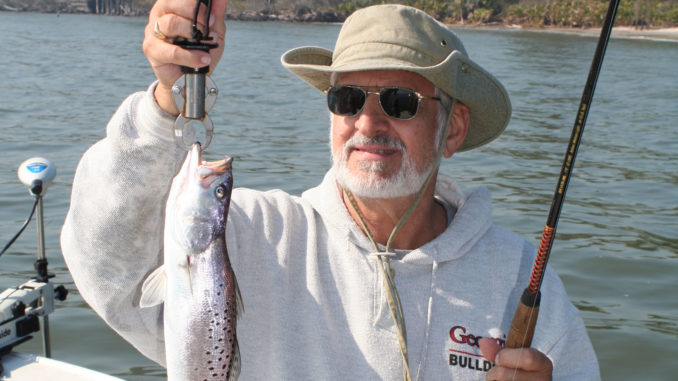
Feeding up as the spawn approaches, big female trout are suckers for the right baits in the right spots at the right times.
Redfish are our No. 1 year-round saltwater target, really the only inshore fish we catch with any consistency during the coldest months. But now with the warming water, baitfish and other forms of forage return to shallow water, and so do the trout. Spotted seatrout, aka speckled trout, the favorite eating fish of many Lowcountry anglers, come out of hibernation and feed on finger mullet, crabs, tiny shrimp, mud minnows or anything else they can get their big mouths around.
Our signature gamefish, spot-tail bass and cobia — the favorite late-spring obsessions of many local anglers — are active, and sight-fishing for them is thrilling on calm, clear days. Alas, not every spring day fits that idyllic picture. Fortunately, the trout bite improves on overcast, windy and rainy days, and when you can find them they are pretty easy to catch. If the weather isn’t perfect and it’s your day to go fishing, target trout.
Most guides in the Beaufort/Hilton Head area don’t focus on trout for their paying patrons, but they all know how to catch them when other bites are few and far between and they need some action. Here’s what a few of them have to say about trout in April.
Capt. Owen Plair at Beaufort’s Baystreet Outfitters said sight-fishing for specks is exceeding rare, because the fish don’t frequent the shallow flats the same way spot-tails do. To find them during high-tide periods, he uses cork rigs and switches to artificials when he gets a steady bite. At mid-tides, he’ll go with bait or artificials, mainly around oyster beds, or structures like docks and rocks. During periods of low water, he works along exposed oysters where the trout are laying up, waiting on bait to pass.
For artificials, Plair fishes mostly scented Gulp! baits, including the 3-insh jerk shad, shrimp and swimming minnow in new penny, chanteuse and pink. Using a 1/4-ounce, red or chartreuse jighead is key to get the artificial into the strike zone. Trout do not generally feed on the surface, often preferring two to four feet of water.
Mud minnows fished under cork rigs are his choice when using bait around oysters at low to mid-tide and at high tide around grass edges, again usually focusing on two to four feet of water. Plair rigs his mud minnows under a Cajun Thunder popping corks, sliding it ahead of 16 to 24 inches of 30-pound monofilament leader, depending on the depth of the area, and he adds a split shot up from a 2/0 circle hook to hold the live bait down.
Trolling is an effective way to target trout, and you can actually pick up an occasional redfish or flounder in the process. When trolling, Plair uses the same artificial set-up, dropping his jigheads behind the boat and trolling along high, spartina grass edges. He keeps his speed at a light idle and watches his rod tips to detect bites. Once he catches a fish trolling, stopping the boat and casting to where he got the first bite will often produce more trout, because they feed aggressively, and they like to hang out in schools of 10 to 50 fish. When you find big schools, it is not unusual to catch several on successive casts.
Capt. Doug Gertis, one of the most-experienced and knowledgeable guides in the Beaufort area, said as the water warms in March and April and an increasing amount of bait moves into the estuaries, trout become active. When the water temperature reaches around 58 degrees, they begin their spawning ritual.
Gertis loves catching and eating trout, and he knows how to catch them year-round, whereas most fishermen target them in late fall, leading into winter. He said, however, that April is a fabulous time to catch big, roe trout. Especially the larger ones, trout are mostly found in deeper water in April, and they generally relate to structure such as bridge pilings, rocks and fallen trees in areas near where they will spawn. One good April spot for the shorebound anglers is the fishing pier at the Broad River. Dropping a bait or jig and trailer near the pilings could be productive. Trout will move up to forage along shell banks that reach out from points, especially large creek mouths and generally in bigger flowing water bodies.
To target big trout, Gertis fishes the deep structure with a slip float and enough line below the bobber stop to put the bait on the bottom, or he uses a Carolina rig. He baits either rig with finger mullet, menhaden, large mud minnows or even gar fish; basically, anything he can catch with his cast net will work for big trout. He strings his bait onto a large, size 3/0 Kahle hook.
Gertis said that the big trout feed ravenously and naturally favor baitfish high in oil content because that translates into more oily egg masses that will float higher in the water column and disperse more rapidly. Mother Nature makes the breeding trout generally pick spots in bigger water for the same reason; more water means the eggs disperse more rapidly and are less likely to be eaten by other fish. Some of his favorite April spots are the deep holes of Archers, Ballast and Battery creeks and the Broad River.
Some trout are still caught in the shallows by cast and retrieve anglers. Gertis loves throwing MirrOLure 52M FT plugs around creek mouths where he looks for clean water — not clear like in winter but also not silted up with mud and sand — and a flow that exhibits a long current line on either side of a shell bank. He fishes these spots on a rising tide as the water pushes back into the creek, casting either side of the current line.
Capt. Dan Utley, one of the most popular guides in the Hilton Head area, is like other guides in that he targets trout only as a fallback when the redfish bite is difficult. When the going is tough, Utley tries to troll up some trout. He will have one of his clients drag a MirrOdine MR17, a 2 5/8-inch a suspending jerkbait with a dark back and shiny sides. On the other client’s spinning rod he ties on a 1/4-ounce chartreuse jig head with a green curlytail trailer. He likes curlytails for trout because they are sight feeders and the extra wiggle from the tail adds attraction.
Utley likes a high, outgoing tide, but the high incoming also works. He focuses mostly on grass banks with oysters and wants his lures to go right over the oysters or right next to them, depending on the water depth. In cloudy water, he gets very close to the structure, in clear water, a little farther away. Trout could be anywhere along such structure, but he especially anticipates action when the baits cross past small feeder creeks.
His trolling speed is slow, and he wants the lures very near the bottom, so he adjusts his speed depending on whether his boat are moving with or against the current. Getting hung up occasionally means your speed is just about right.
Once he hooks a fish, Utley uses the “three strikes” method for covering the productive area. He will troll back past the spot until he makes three unproductive passes, then moves on to try new water. With clients who are good casters, he often stops and thoroughly works productive spots with the same lures.
One of Utley’s secrets for successful trout success is taking notes. He suggests developing your own list of trout “drops” where you have found and caught fish. When you are trolling and get a hit, make a note of the stage and time of the tide and the season, as well as marking a waypoint with your GPS. Odds are pretty good there will be trout in that area the next time you’re out fishing similar conditions.
A couple other things Utley looks for when searching for trout are back creeks at big bends or areas with fallen trees in the water. One of his favorite spots in higher water is the Rose Island Cut between the Chechessee and the Broad rivers .
For Julian Johnson of the Island Meat Market on Lady’s Island, trolling for trout is not a back-up plan, but what he loves to do any time he isn’t in his shop cutting fine steaks and chops. Admittedly, trolling is not rocket science, but some folks like Johnson are much better at it than others. He starts with a 1/4-ounce chartreuse jighead and an electric chicken-colored soft-plastic trailer on a medium-action spinning rod. He lets out 30 to 40 feet of line and drags the lure behind his boat at a slow three to four mph pace so the bait is running well below the surface.
Johnson prefers the falling tide when the water has just left the edge of the grass; he trolls his baits close to the bank where they’re in four to five feet of water. He will often move the rod forward and then drop it back to create variations in the speed and depth the bait is running.
Strikes are often subtle and never require an aggressive hookset because of trout’s fragile mouths. Once a fish is hooked, Johnson takes note of the spot, because more often than not, more trout are close by. The options are to stop and cast at the spot or troll past it again. Johnson suggests using a net for landing fish because many escape at the boat.
DESTINATION INFORMATION
HOW TO GET THERE — Beaufort is most-easily accessed from I-95 via US 21; while Bluffton and Hilton Head are accessed from I-95 via US 278. Anglers working the Broad River area often use the excellent landing on SC 170 at the Chechessee River bridge or the Broad River landing on SC 170 at the base of the Broad River bridge. Both are about halfway between Bluffton and Beaufort. For a complete listing of free public landings, visit www.dnr.sc.gov/mlands/boatramp.
WHEN TO GO — Trout stir and begin to bite in late March and April when the water temperature reaches the upper 50s; spawning begins at around the 58-degree mark. Trout will bite at any stage of the tide, but most guides and pros prefer fishing at the top end, either coming in or going out. Overcast or bad-weather days are also excellent for specks.
GUIDES/FISHING INFO — Bay Street Outfitters, Beaufort, 843- 524-5250; Grayco Hardware, Lady’s Island, 843-521-8060; Beaufort Boat and Dock Supply, Port Royal, 843-986-0552; Capt. Tuck Scott, 843-271-5406; Capt. Owen Plair, 843-524-5250; Capt. Doug Gertis, 843-521-9896; Capt. Dan Utley, 843-368-2126; Capt. Jack Brown, 843-838-9369; Capt. Richard Sykes, 843-524-5250. See also Guides and Charters in Classifieds.
ACCOMMODATIONS — Beaufort Area Chamber of Commerce, 843-986-5400.
MAPS — Capt. Segull’s Nautical Charts, 888-473-4855, www.captainsegullcharts.com; Top Spot Waterproof map N233 is available from local tackle shops; Waterproof Charts 93F, 800-423-9026, www.waterproofcharts.com.

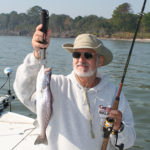
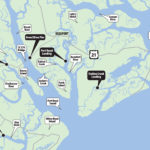
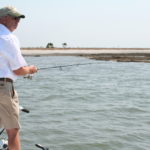
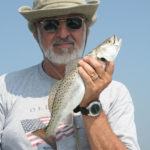



Be the first to comment